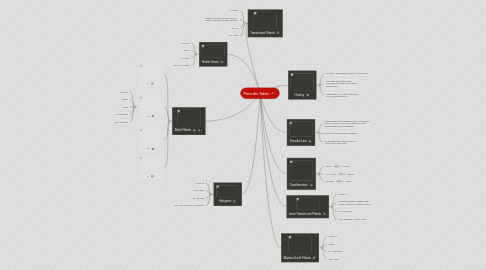Periodic Table
by Dakota Tracer


1. Alkali Metals
1.1. K
1.2. Cs
1.2.1. Group 1A
1.2.2. Metals
1.2.3. Solids
1.2.4. Ex.: Potassium
1.2.5. Uses: Medicine
1.3. Rb
1.4. Li
2. Halogens
2.1. Group 7A
2.2. Non-Metals
2.3. Ex.: Chlorine
2.4. Uses: Pool Chemicals, Light Bulbs
3. Noble Gases
3.1. Group 8A
3.2. Gases
3.3. ex: Neon
3.4. Uses: Neon Lights
4. Transitional Metals
4.1. Group B
4.2. highest Occupied s sublevel and a nearby d sublevel contains electrons
4.3. ex: iron
4.4. Uses: Steel
5. History
5.1. Mendleev, and Greman Chemist J.W.Doberiner
5.2. J.W. made the periodic table Mendleev profected it and made it easier to use
5.3. Todays table is aranged in the order of of increasing atomic #
6. Periodic Law
6.1. when elements are arrangedin order of increasing atomic #, there is a periodic repetition of their physical and chemical properties.
6.2. the law of elements being arranged
6.3. Ex. hydrogen has a atomic mass of 1 so its first on the chart
7. Classifacation
7.1. Metals
7.1.1. Copper
7.2. Non-Metals
7.2.1. Carbon
7.3. Metaloids
7.3.1. Silicon
